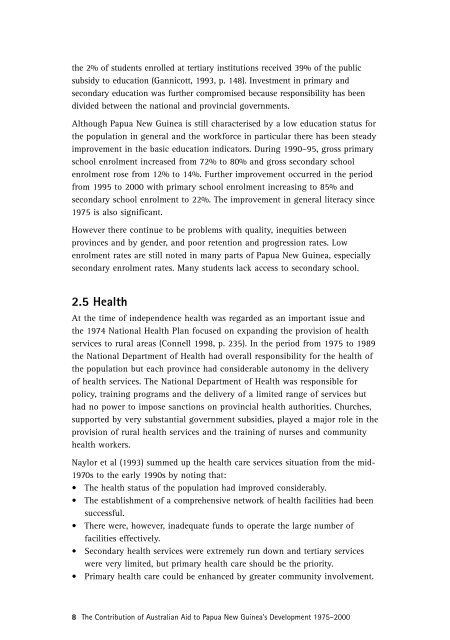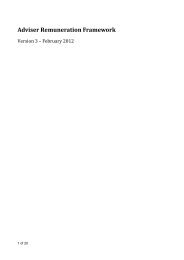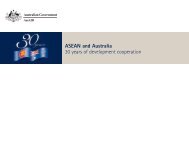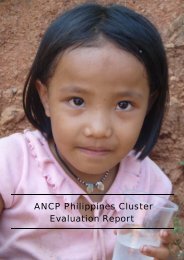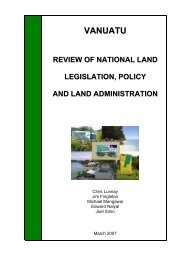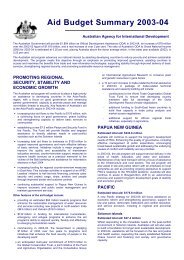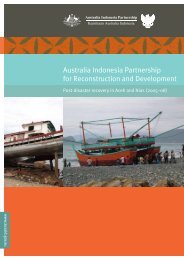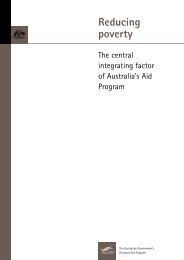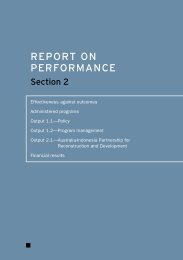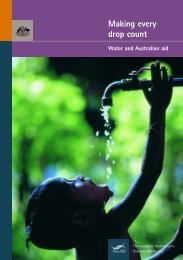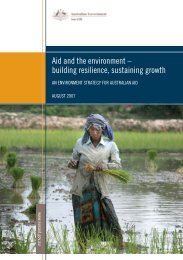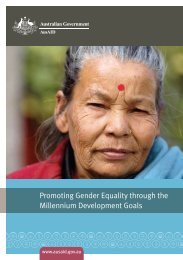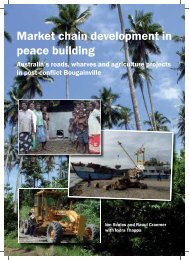Australian Aid to PNG - AusAID
Australian Aid to PNG - AusAID
Australian Aid to PNG - AusAID
You also want an ePaper? Increase the reach of your titles
YUMPU automatically turns print PDFs into web optimized ePapers that Google loves.
the 2% of students enrolled at tertiary institutions received 39% of the publicsubsidy <strong>to</strong> education (Gannicott, 1993, p. 148). Investment in primary andsecondary education was further compromised because responsibility has beendivided between the national and provincial governments.Although Papua New Guinea is still characterised by a low education status forthe population in general and the workforce in particular there has been steadyimprovement in the basic education indica<strong>to</strong>rs. During 1990–95, gross primaryschool enrolment increased from 72% <strong>to</strong> 80% and gross secondary schoolenrolment rose from 12% <strong>to</strong> 14%. Further improvement occurred in the periodfrom 1995 <strong>to</strong> 2000 with primary school enrolment increasing <strong>to</strong> 85% andsecondary school enrolment <strong>to</strong> 22%. The improvement in general literacy since1975 is also significant.However there continue <strong>to</strong> be problems with quality, inequities betweenprovinces and by gender, and poor retention and progression rates. Lowenrolment rates are still noted in many parts of Papua New Guinea, especiallysecondary enrolment rates. Many students lack access <strong>to</strong> secondary school.2.5 HealthAt the time of independence health was regarded as an important issue andthe 1974 National Health Plan focused on expanding the provision of healthservices <strong>to</strong> rural areas (Connell 1998, p. 235). In the period from 1975 <strong>to</strong> 1989the National Department of Health had overall responsibility for the health ofthe population but each province had considerable au<strong>to</strong>nomy in the deliveryof health services. The National Department of Health was responsible forpolicy, training programs and the delivery of a limited range of services buthad no power <strong>to</strong> impose sanctions on provincial health authorities. Churches,supported by very substantial government subsidies, played a major role in theprovision of rural health services and the training of nurses and communityhealth workers.Naylor et al (1993) summed up the health care services situation from the mid-1970s <strong>to</strong> the early 1990s by noting that:• The health status of the population had improved considerably.• The establishment of a comprehensive network of health facilities had beensuccessful.• There were, however, inadequate funds <strong>to</strong> operate the large number offacilities effectively.• Secondary health services were extremely run down and tertiary serviceswere very limited, but primary health care should be the priority.• Primary health care could be enhanced by greater community involvement.8 The Contribution of <strong>Australian</strong> <strong>Aid</strong> <strong>to</strong> Papua New Guinea’s Development 1975–2000


